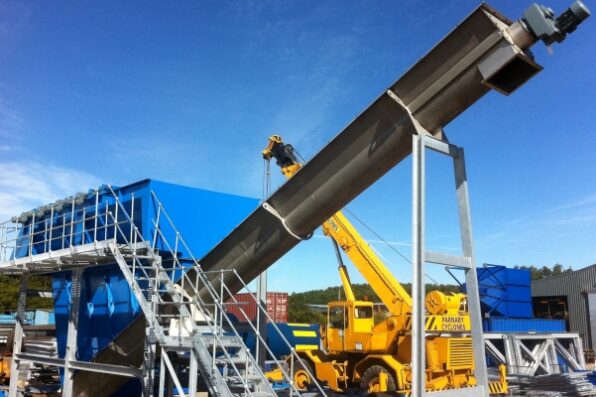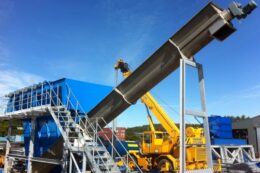County Durham, DL17 0SH, UK
The Plastic Recycling Process
17th June, 2018 by Parnaby Cyclones

The plastic recycling process can be defined as a process carried out in a plastic recycling plant in which used plastic wastes and containers are converted into a reusable form for plastic production. The recycled plastic pellets from the plastic recycling plant can then be used for making container or non-container plastic products.
Generally, plastics are divided into two main classes which are thermoplastic and thermosets. Thermoplastics can be melted and remolded and thus are 100% recyclable while thermosets are not. Such unrecyclable plastic products are manufactured through a different process and can pose serious recycling problems if put into a plastic recycling plant in a recycling process.
Basically, A typical plastic recycling process involves up to 5 different stages in a plastic recycling plant which is sorting, washing, shredding, identification and separation, and then compounding.
The process begins with sorting and used plastic wastes are automatically sorted by passing it through into a sorting station where the plastic is sorted and separated according to different nature of materials, colors, and how the materials are made. This is the first process in a plastic recycling plant and it helps to remove impurities from the plastic containers. This stage is very important because different types of plastic will be processed in different ways and some plastic recycling plant is only capable of recycling one type of plastic.
Further, the plastic is moved to a washing plant or equipment within the plastic recycling plant where the washing process takes place before the plastic is further processed. This is done to remove impurities and all other non-plastic materials from the plastic. All the non-plastic materials and impurities all have to be removed so as not to affect the structure of the final product of the recycling process.
Next, the plastic undergoes shredding and it is granulated to form smaller plastic particles so as increase its surface area for further process and transportation down the processing line in the plastic recycling plant. Also, it creates a means for equipment such as metal detectors to be able to remove some metallic impurities that might have made their way after the washing stage.
Further, the plastic passes through the identification and separation stage in the plastic recycling plant where its particles are tested to assess their quality and class. Firstly, the particles will be floated to test for density in a large tank of water, less dense particles will float while denser ones will sink. Next, their thickness or size is tested by passing them through a small wind tunnel so that smaller pieces will fly higher while the bigger pieces will fly lower in the tunnel. Other qualities like melting point and color are checked by collecting and analyzing samples of each batch of plastic particles from the plastic recycling plant.
Lastly, the particles undergo a compounding process where the small particles are smashed and melted together into plastic pellets. The pellets can then be used in the plastic production process.
Ideally, the separation could either employ a dry or wet processing method. The dry processing method is known to always produce highly contaminated plastic and thus it is less efficient and effective than the wet counterpart.
The wet process involves the use of a plastic washing plant that combines the process of separation, washing, dewatering and sizing as part of a closed-loop treatment system. The pre-processed plastic particles under after the shredding stage from a plastic recycling plant are passed into a plastic washing plant which separates the plastic from all forms of impurities such as metals and paper labels, washes the plastic particles, de-water the particles, and pass them through a sizing screen to produce different size of the plastic particles. This is one of the most efficient forms of recycling of any type of commercial waste, with almost 100% recovery of the original material in an extremely clean and pure form, with fantastic environmental benefits.
The Plastic Recycling Process
17th June, 2018 by Parnaby Cyclones

The plastic recycling process can be defined as a process carried out in a plastic recycling plant in which used plastic wastes and containers are converted into a reusable form for plastic production. The recycled plastic pellets from the plastic recycling plant can then be used for making container or non-container plastic products.
Generally, plastics are divided into two main classes which are thermoplastic and thermosets. Thermoplastics can be melted and remolded and thus are 100% recyclable while thermosets are not. Such unrecyclable plastic products are manufactured through a different process and can pose serious recycling problems if put into a plastic recycling plant in a recycling process.
Basically, A typical plastic recycling process involves up to 5 different stages in a plastic recycling plant which is sorting, washing, shredding, identification and separation, and then compounding.
The process begins with sorting and used plastic wastes are automatically sorted by passing it through into a sorting station where the plastic is sorted and separated according to different nature of materials, colors, and how the materials are made. This is the first process in a plastic recycling plant and it helps to remove impurities from the plastic containers. This stage is very important because different types of plastic will be processed in different ways and some plastic recycling plant is only capable of recycling one type of plastic.
Further, the plastic is moved to a washing plant or equipment within the plastic recycling plant where the washing process takes place before the plastic is further processed. This is done to remove impurities and all other non-plastic materials from the plastic. All the non-plastic materials and impurities all have to be removed so as not to affect the structure of the final product of the recycling process.
Next, the plastic undergoes shredding and it is granulated to form smaller plastic particles so as increase its surface area for further process and transportation down the processing line in the plastic recycling plant. Also, it creates a means for equipment such as metal detectors to be able to remove some metallic impurities that might have made their way after the washing stage.
Further, the plastic passes through the identification and separation stage in the plastic recycling plant where its particles are tested to assess their quality and class. Firstly, the particles will be floated to test for density in a large tank of water, less dense particles will float while denser ones will sink. Next, their thickness or size is tested by passing them through a small wind tunnel so that smaller pieces will fly higher while the bigger pieces will fly lower in the tunnel. Other qualities like melting point and color are checked by collecting and analyzing samples of each batch of plastic particles from the plastic recycling plant.
Lastly, the particles undergo a compounding process where the small particles are smashed and melted together into plastic pellets. The pellets can then be used in the plastic production process.
Ideally, the separation could either employ a dry or wet processing method. The dry processing method is known to always produce highly contaminated plastic and thus it is less efficient and effective than the wet counterpart.
The wet process involves the use of a plastic washing plant that combines the process of separation, washing, dewatering and sizing as part of a closed-loop treatment system. The pre-processed plastic particles under after the shredding stage from a plastic recycling plant are passed into a plastic washing plant which separates the plastic from all forms of impurities such as metals and paper labels, washes the plastic particles, de-water the particles, and pass them through a sizing screen to produce different size of the plastic particles. This is one of the most efficient forms of recycling of any type of commercial waste, with almost 100% recovery of the original material in an extremely clean and pure form, with fantastic environmental benefits.

